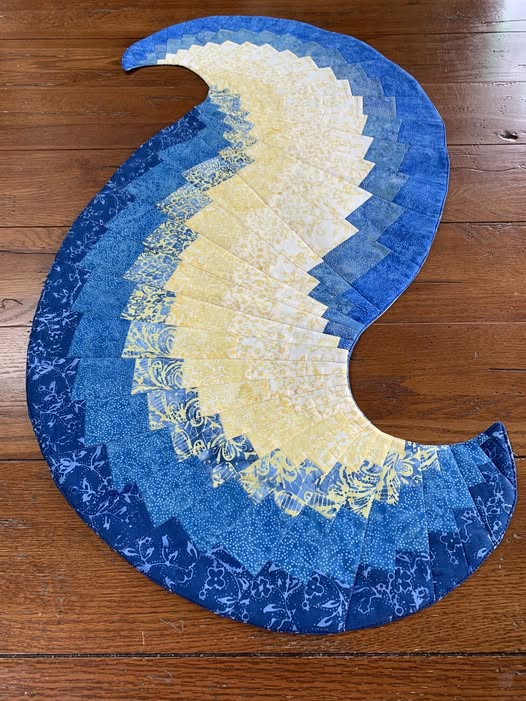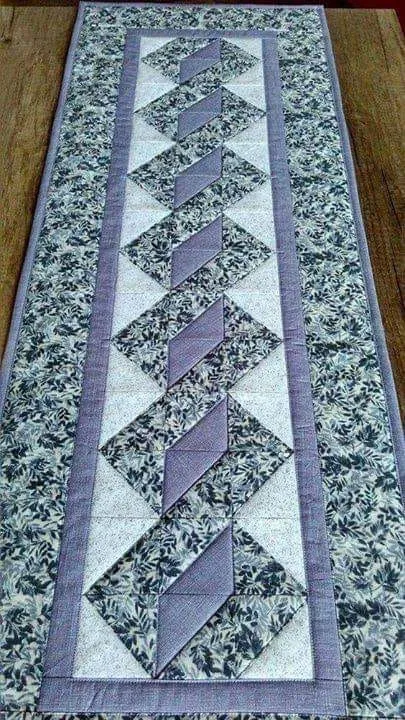
The Twisted Pole Table Runner – Free Quilt Pattern is a striking and creative project that combines classic quilting techniques with modern design elements.
Its unique “twisted pole” effect gives the piece a dynamic look, making it a perfect centerpiece for dining tables, coffee tables, or sideboards.
This free pattern is suitable for both beginner and intermediate quilters, offering a fun way to practice precision cutting, piecing, and layout while creating a functional decorative piece.

Starting a Twisted Pole Table Runner – Free Quilt Pattern is an exciting opportunity to explore color combinations, textures, and geometric design.
Each strip, when carefully selected and sewn, contributes to the twisting visual effect that gives the table runner its name. The pattern balances simplicity and sophistication, allowing quilters to showcase their creativity while producing a practical home décor item.
This table runner works beautifully for any season, whether using warm fall tones, pastel spring colors, or festive holiday shades. In this guide, you’ll learn about choosing fabrics, cutting and assembling pieces, finishing techniques, and creative variations to make your Twisted Pole Table Runner – Free Quilt Pattern truly unique. By the end, you’ll have a clear roadmap to complete a stunning quilted table runner that enhances any living space.
Selecting the right fabrics is crucial for achieving the twisting visual effect in the Twisted Pole Table Runner – Free Quilt Pattern. Begin with a combination of contrasting and coordinating fabrics to create depth and movement. Solid fabrics, small-scale prints, and subtle textures can be mixed to enhance the design without overpowering it.
Cotton fabric is recommended for its durability and ease of handling. Pre-wash all fabrics to prevent shrinkage and ensure colorfastness. Choose 3-5 main colors to create a cohesive palette, balancing light and dark shades to emphasize the twist effect. For example, alternating dark and light strips along the pole creates a sense of motion and dimension.
In addition to main fabrics, consider accent colors for borders or cornerstones. These small touches can highlight the twisting sections and frame the table runner beautifully. Coordinating thread colors are also essential; use neutral thread for general seams and matching or contrasting thread for decorative topstitching.
When planning your layout, arrange fabric strips on a design wall or flat surface. Move them around until you achieve a visually satisfying balance of color and contrast. This step ensures that the twisting pole effect is prominent and visually appealing throughout the table runner.
Finally, don’t forget to choose backing fabric and batting. The backing can be a coordinating print or solid color, while a lightweight cotton batting works best to maintain flexibility and drape, allowing your Twisted Pole Table Runner – Free Quilt Pattern to lay flat on the table without stiffness.
Precise cutting is key to achieving the clean lines required for the Twisted Pole Table Runner – Free Quilt Pattern. Measure and mark your fabrics carefully using a rotary cutter, ruler, and cutting mat. Standard table runner blocks often measure around 4-6 inches wide, but you can adjust based on your desired dimensions.
Start by cutting strips of fabric according to your planned layout. Each strip will form part of the twisting effect, so uniform width is essential. Consider using a strip piecing method, sewing multiple strips together in sections before cutting them into individual blocks. This approach saves time and maintains consistency.
Assemble your blocks by sewing strips together, alternating colors to achieve the twist illusion. Press seams toward darker fabrics to create depth, and ensure each seam line is straight and aligned. Double-check measurements at each step to maintain uniformity and ensure a professional finish.
After assembling the blocks, lay them out in order to preview the twisting effect. Adjust as needed before sewing the blocks into rows. Matching seams carefully ensures the twist pattern flows smoothly across the entire table runner.
Finally, sew all rows together to complete the top of your Twisted Pole Table Runner – Free Quilt Pattern. Press the seams flat and square the edges to prepare for layering and quilting. The precision during cutting and piecing determines how striking and clean the finished twist effect will appear.
Quilting adds texture, stability, and dimension to the Twisted Pole Table Runner – Free Quilt Pattern. You can choose between straight-line quilting, free-motion quilting, or a combination of both, depending on your style and experience level. Straight-line quilting works well to emphasize the geometric twist, while free-motion designs can add flowing elements that enhance the movement of the poles.
Layer the quilt top, batting, and backing fabric, ensuring all layers are smooth and free of wrinkles. Pin or baste the layers securely to prevent shifting during quilting. Cotton or bamboo batting is recommended for a lightweight but stable finish, allowing your table runner to drape naturally over furniture.
Quilt along the seams or in patterns that complement the twisting design. Consider echo quilting around the poles to emphasize their shape, or create diagonal lines to add a dynamic texture. The quilting should enhance the design without overwhelming the visual effect of the twist.
After quilting, trim any excess batting and backing fabric to match the edges of the top. Prepare binding strips from coordinating fabric and sew them neatly around the perimeter of the table runner. This finishing step reinforces edges, adds durability, and gives a polished look to your Twisted Pole Table Runner – Free Quilt Pattern.
Finally, press the completed table runner gently to remove any wrinkles and set the seams. Your table runner is now ready to display as a functional and decorative centerpiece in your home.
The Twisted Pole Table Runner – Free Quilt Pattern allows for endless creative variations. Experiment with different fabric combinations to suit seasons, holidays, or your home décor. For example, using warm autumn tones with gold accents creates a festive feel, while pastel shades offer a light, springtime aesthetic.
You can also vary the block sizes to adjust the scale of the twist effect. Larger blocks create bold, dramatic lines, while smaller blocks produce a more intricate, detailed design. Mixing prints and solids further enhances the visual interest of your table runner.
Adding appliqué, embroidery, or decorative stitching along the twisting poles can personalize your project. These embellishments can highlight the twist or add thematic motifs, such as flowers, leaves, or geometric shapes.
For versatility, consider making matching coasters or placemats using the same twist pattern. This creates a coordinated set that can be used as a gift or to elevate your table décor.
You can also experiment with alternative materials like linen, canvas, or even lightweight wool for a textured, tactile effect. Each variation allows your Twisted Pole Table Runner – Free Quilt Pattern to reflect your creativity and style.
Lastly, consider reversible designs by choosing complementary fabrics for the front and back. This adds extra functionality, allowing the table runner to be flipped for a completely different look.
1. Is this table runner pattern suitable for beginners?
Yes, it’s beginner-friendly. Basic sewing and piecing skills are sufficient to create a beautiful finished product.
2. What fabrics work best for this pattern?
Medium-weight cotton is ideal for the quilt top, with lighter cotton for lining or backing. Small-scale prints and solids create the best visual contrast.
3. Can I adjust the size of the table runner?
Absolutely. Adjust the block size and number of strips to create a runner that fits your table.
4. What quilting technique works best?
Straight-line or echo quilting enhances the twist effect, while free-motion quilting adds texture and flow.
5. Can I add borders to this table runner?
Yes, borders help frame the design and add a polished finish. Choose a contrasting or complementary fabric for visual interest.
6. How do I care for my table runner?
Machine wash gently in cold water, or hand wash to preserve colors. Lay flat or tumble dry on low heat to maintain shape.
7. Can I customize this design for different occasions?
Yes, by changing fabric colors and adding embellishments, you can create seasonal, holiday-themed, or personalized versions of your Twisted Pole Table Runner – Free Quilt Pattern.
The Twisted Pole Table Runner – Free Quilt Pattern is a fun, creative project that combines style, functionality, and artistic expression. Its unique twist design adds dynamic visual appeal, making it a perfect centerpiece for any table. By carefully choosing fabrics, precise cutting, and thoughtful quilting, you can create a stunning table runner that reflects your personal style and enhances your home décor.
This pattern encourages experimentation with colors, fabrics, and techniques, offering countless creative possibilities. Whether you are making this table runner for yourself, as a gift, or for display, the process of creating it provides satisfaction and pride in your craftsmanship.
We hope this guide has inspired you to start your Twisted Pole Table Runner – Free Quilt Pattern. Share your results, leave honest feedback, and suggest any creative variations you discover. Your experiences will inspire others and keep the quilting community thriving.
